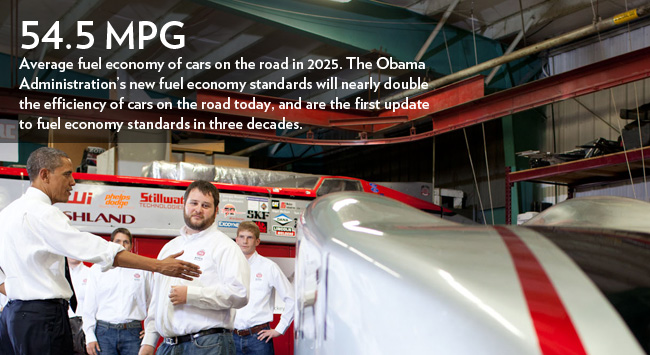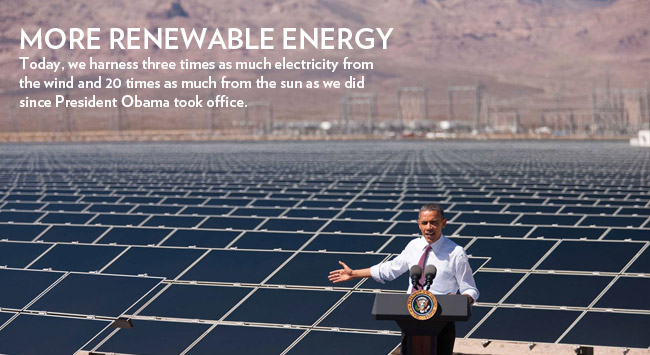Energy and Environment Latest News
Empowering Developing Nations to Boost Their Own Climate Resilience
Posted by on June 9, 2015 at 9:45 AM EDTToday, at the U.S. Institute of Peace, the United States and partners from around the world are delivering on President Obama’s commitment to help empower developing nations to boost their own climate resilience.
The Climate Services for Resilient Development Partnership, initially announced by the President at the UN Climate Summit in New York last September, will provide actionable science, data, information, tools, and training to developing countries that are working to strengthen their national resilience against the impacts of climate change. The Partnership is launching with more than $34 million in financial and in-kind contributions from the U.S. government and seven other founding-partner institutions from around the world: the American Red Cross, Asian Development Bank, Esri, Google, Inter-American Development Bank, the Skoll Global Threats Fund, and the U.K. government.
Climate change threatens our entire planet. The impacts of climate change – including more intense storms and storm surge damage, more severe droughts and heat waves, sea-level rise, ocean acidification, and biodiversity losses – are already being experienced in different ways around the world. These impacts can be particularly damaging in developing countries, which often lack the resources and technical capacity to effectively prepare for and adapt to the effects of climate change.
Learn more about Energy and EnvironmentA Very Presidential Red-tailed Hawk
Posted by on June 4, 2015 at 10:51 AM EDTEd. note: This blog is cross-posted from the National Audubon Society. You can read the original post here

A young Red-Tailed Hawk perches near its new stomping grounds—the White House. Photo: DJ Patil
Despite its manicured gardens and bruising security detail, the White House is wilder than you’d think. Over the centuries it has served as the temporary residence of not just every president since John Adams (the Clinton years were especially untamed) but also birds, raccoons, and even a rogue fox.
The latest visitor? A juvenile Red-tailed Hawk.
Learn more about Energy and EnvironmentFaith Leaders as Climate Champions of Change
Posted by on June 3, 2015 at 6:00 PM EDTIn June 2013, President Obama outlined the Climate Action Plan -- his roadmap for action in the second term that cuts carbon pollution, helps prepare our country for the impacts of climate change, and continues to lead international efforts to address global climate change. President Obama believes in the power of individuals to make a difference on these issues. He also knows the faith community has a powerful role in leading climate change efforts.
As the President has said:
Let’s do more to promote … development … from ending extreme poverty to saving lives, from HIV/AIDS to combating climate change so that we can preserve God’s incredible creation. On all these issues, faith leaders and faith organizations here in the United States and around the world are incredible partners, and we're grateful to them.
This July, the White House will honor faith leaders who are making a difference to combat climate change and advance conservation in their communities. We will celebrate the impact they are having here at home, and on the lives of people around the world.
Learn more about Energy and Environment,Name That Bird: Our Invitation to One Fourth-Grade Class
Posted by on June 3, 2015 at 2:00 PM EDTUPDATE FROM BRIAN DEESE:
After a spirited debate and multiple rounds of voting, the students of Jim Cutting’s fourth-grade class decided on a name befitting a White House raptor:
The students’ reasoning? Well, a political moniker seemed apt, given this young bird’s proclivity for the East Wing. And the name recognizes the visionary leadership of our 16th President and the proximity of the Lincoln Memorial to the White House—all with the added bonus of sneaking in a plug for their school (Lincoln Akerman School in Hampton Falls, New Hampshire).

Great job, class! Thanks for helping us out.
It can be easy to forget that the White House is actually a national park — because usually, our wildlife doesn’t get more exotic than the black squirrels that are common here in Washington. But sometimes we’re reminded that nature often finds a way, even in downtown D.C.
Most recently, we discovered that a red-tailed hawk has taken up residence on the grounds. The hawk’s presence reminds us that birds of prey can sometimes adapt to urban environments, substituting telephone poles, skyscrapers, and the Eisenhower Executive Office Building for the rock ledges they usually nest and perch on — but also of how these birds are imperiled in the wild, as unofficial White House birder-in-residence Tamara Dickinson wrote earlier this week.
But since this hawk has chosen the White House as a place to nest and rest — and find plenty of squirrels — we think it makes sense to give it a name. And we know just the people to suggest one.
Learn more about Energy and EnvironmentUpping Our Game for Disaster Preparedness and Response
Posted by on June 3, 2015 at 11:05 AM EDTLast Thursday the President was in Miami for the 2015 Hurricane Briefing at the National Oceanic and Atmospheric Administration (NOAA)’s National Hurricane Center. Briefing topics included forecast details for the coming hurricane season as well as an overview of technology, tools, and teams supporting preparedness and response efforts led by NOAA, the Federal Emergency Management Agency, the Department of Defense, and other Federal, state, and local entities.
The briefing covered resources like the Administration’s Climate Resilience Toolkit, a website that provides centralized, authoritative, easy-to-use information, tools, and best practices to help communities prepare for and boost their resilience to the impacts of climate change. For instance, the Climate Resilience Toolkit’s Coastal Flood Exposure Mapper tool creates visualizations that overlay projections of future sea level rise with the locations of critical infrastructure in coastal areas, helping users to target preparedness and response efforts to high-priority areas.
The Climate Resilience Toolkit is one example of the resources that individuals and organizations rely on for effective disaster preparedness and response. In the aftermath of Hurricane Sandy, in October 2012, the Federal government made it a priority to improve such resources by expanding engagement with a broad range of community members to contribute their talents, needs, unique skills, and perspectives in building tools and sharing information before, during, and after a crisis. This led to the April 2013 launch of the White House Innovation for Disaster Response and Recovery Initiative — a government-wide effort to strengthen our ability to cope with disasters.
Since then, the Administration has continued to work collaboratively in the area of community engagement and crowd-sourced innovation to develop #disastertech resources to enhance our disaster preparedness and response capabilities.
Learn more about Energy and Environment, , TechnologyPresident Obama Hosts a Question-and-Answer Session with Young Southeast Asian Leaders
Posted by on June 1, 2015 at 7:53 PM EDTToday, as part of the Young Southeast Asian Leaders Initiative, President Obama hosted a meeting with 75 emerging leaders from the Association of Southeast Asian Nations (ASEAN) at the White House. The Young Southeast Asian Leaders Initiative encourages civic and government leaders from Southeast Asia to enhance their leadership skills and work with their American counterparts to help promote economic empowerment, good governance, and environmental and natural resources management in their home countries.
Learn more about , Energy and Environment
- &lsaquo previous
- …
- 2
- 3
- 4
- 5
- 6
- 7
- 8
- 9
- 10
- …
- next &rsaquo
White House Blogs
- The White House Blog
- Middle Class Task Force
- Council of Economic Advisers
- Council on Environmental Quality
- Council on Women and Girls
- Office of Intergovernmental Affairs
- Office of Management and Budget
- Office of Public Engagement
- Office of Science & Tech Policy
- Office of Urban Affairs
- Open Government
- Faith and Neighborhood Partnerships
- Social Innovation and Civic Participation
- US Trade Representative
- Office National Drug Control Policy










